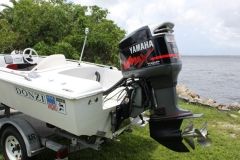2005 series 350 Mag MPi with Bravo One drive, 191 hours, factory stock.
No prior overheats that could not be traced to either a plastic bag floating in the water, or a temporary and minor influx of mud in shallow water. All cleared long ago. No overtemps in the past two years.
A couple outings ago the boat showed a slight tendency to run up a few degrees when coming off of plane. However, it would come down to normal within a few minutes of idling. Then the last time out, it ran hotter and hotter right from the beginning. The digital temp gauge showed 184 while at 3300 rpm's. Normally it stays right at 159 degrees once it warms up. When I came off plane and slowed down, the alarm went off and the digital temp briefly read 224. The analog gauge quickly pegged. Fortunately, I was back at my dock when that happened.
So, a very competent mechanic looked it over and we agreed that it could be either the thermostat, the impeller, or the curvy hose that chokes up inside Bravo Ones. So he replaced all three. He ran it on the hose and water came out of all the right places while idling, and he didn't think it was running too hot. He did put in a 170 deg thermostat and he stated that it stayed within that range. The old impeller was worn only slightly from normal use. No missing blades or chunks. Thermostat looked normal for 5 years in brakish water. The hose in the drive was extremely constricted from the outside from the expected 5 years of corrosion build-up on the outside of the hose that eventually crushes them down. I was told by several sources that this is a common problem.
No oil in the water. No water in the oil. Oil did not seem too hot, even with the overtemp readings. Full synthetic Mercury spec oil. Only 12 hours since that was last changed with the filter.
Brand new drive belt at that same time as oil change. Belt turning, all aux items rotating, no funny noises, engine does not smell hot or even feel particularly hot. No hot engine clicking sounds or boiling water sounds. no smoke or odors of any kind. Engine compartment temp normal.
So, I put it back in the water and off I went for a test ride. It began to overheat immediately. The digital temp gauge went up at a pretty consistent rate, and I turned back to the dock after only 5 minutes running. Digital temp got to 184 as I was coming off plane. Alarm went off, and the analog temp gauge pegged. At the the dock at idle, no water coming out of the through hull tips.
Back on the hose and up on the stand, the water came through all the right places, although the tips seemed a bit weak to me. But that could have been the angle of the boat on the stand. I have the permanently open Y-style Quick 'n' Quiet exhaust. No Captains Choice switch. Water always comes through both the tips and the exhaust port on the drive. Water was running freely from the outdrive port. Engine temp began to rise well through the 170 thermostat to 175 and I cut it off. Water coming out of the tips was only luke warm to the touch.
So water can be pushed through the system under pressure, but it won't do it on its own.
Water pump in the drive?
Water pump housing in the engine?
Thermostat housing blocked?
Exhaust Manifolds?
Heads?
I did lots of searches here before posting. Looks like it could be a number of (expensive) things at this point.
What say you?
(P.S. I have to be very careful what I wish for because it often comes true. In this case I have been waiting impatiently for 5 years for the risers and exhaust manifolds to clog up so I could order a new stainless steel EMI Thunder exhaust manifold and riser package. Did my Genie come through for me right on schedule?)







 Reply With Quote
Reply With Quote











